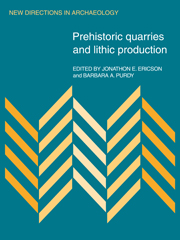Book contents
- Frontmatter
- Contents
- List of contributors
- Dedication
- Part 1 Introduction
- Part 2 Procurement, production, and exchange
- Part 3 Technology and techniques
- 10 Jigsaw: reconstructive lithic technology
- 11 Quarry studies: technological and chronological significance
- 12 Characterization of selected soapstone sources in southern New England
- 13 Reconstructing Corbiac: the context of manufacturing at an Upper Paleolithic quarry
- Index
11 - Quarry studies: technological and chronological significance
Published online by Cambridge University Press: 04 August 2010
- Frontmatter
- Contents
- List of contributors
- Dedication
- Part 1 Introduction
- Part 2 Procurement, production, and exchange
- Part 3 Technology and techniques
- 10 Jigsaw: reconstructive lithic technology
- 11 Quarry studies: technological and chronological significance
- 12 Characterization of selected soapstone sources in southern New England
- 13 Reconstructing Corbiac: the context of manufacturing at an Upper Paleolithic quarry
- Index
Summary
Quarry sites contain thousands of years of debitage in quantities that can be studied statistically. Paradoxically, quarry sites, unlike other types of sites, have not been subjected to routine archaeological inquiry. In this paper I describe procedures we are using in Florida to resolve questions about lithic technology and the antiquity of chert quarries. The enduring consequence of the research is the realization that extraction methods utilized by prehistoric stoneworkers were applied eventually to other technologies and that the data resulting from the studies have implications extending beyond archaeological interests.
Introduction
As the papers in this volume confirm, studies of quarry sites contribute to the archaeological interpretation of a region and to an understanding of culture in general. In fact, a significant dimension of culture is missing if a people's stoneworking technology, including quarry-site behavior, is ignored.
Individuals who investigate quarry sites must be interested in technology, not merely finished products. The vast amounts of broken stone at quarries is uninteresting to most archaeologists and partially explains why procurement areas have not been studied thoroughly. Aboriginal chert quarries in Florida had not been investigated prior to my excavations at the Senator Edwards Site (Purdy 1975; 1981a, 105), the York Site (Purdy 1977), the Container Corporation of America Site (Purdy 1981b), and Hemmings and Kohler's work at the Lake Kanapaha Site (1974).
- Type
- Chapter
- Information
- Prehistoric Quarries and Lithic Production , pp. 119 - 128Publisher: Cambridge University PressPrint publication year: 1984
- 7
- Cited by



